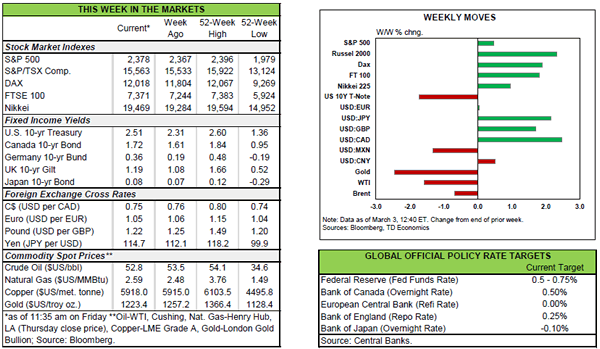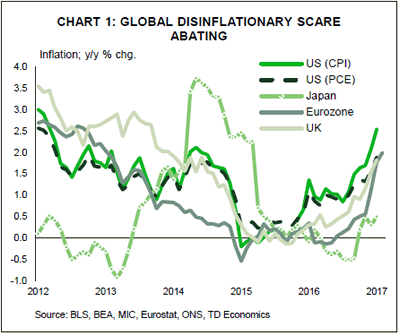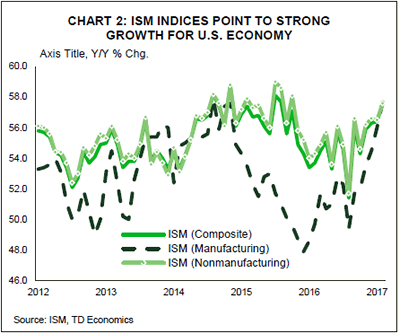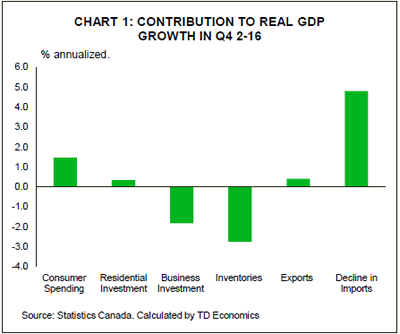HIGHLIGHTS OF THE WEEK
United States
- It was an exciting week in markets this week, with plenty of domestic and international first-tier data, central bank communication, and the inaugural presidential address to Congress.
- International data has continued to paint a relatively bright picture of the world economy with inflation picking up in the Eurozone, Japan, and the U.K. The positive sentiment was further buoyed by strong PMI data across the globe, suggestive of a strong start to 2017.
- U.S. data was even more encouraging. Apart from some weakness in real spending and construction in January, which came on the back of a strong fourth-quarter, data on from purchasing managers pointed to building strength, with solid momentum in early-2017 also exhibited by regional business surveys, price metrics, and labor market indicators.
- In light of the strong data flow and increasingly hawkish rhetoric out of the Fed, we believe the FOMC will likely raise rates at its next meeting in mid-March, barring any downside surprises, with markets increasingly turning their focus from "when" to "how quickly" any potential hikes may come.
Canada
- Canadian real GDP beat most forecasters expectations, rising 2.6% annualized in the fourth quarter of 2016 and has considerable momentum heading into 2017.
- To no one’s surprise, The Bank of Canada remained on hold yet again. While the economy is likely to beat the expectations laid out in the January MPR, the central bank has plenty of reasons to hold on to their dovish tone.

UNITED STATES – FED PRIME MARKETS FOR MARCH HIKE, AIMING FOR HAT-TRICK IN 2017
It was an exciting week in markets this week. Alongside a much awaited tech IPO, there were plenty of first-tier data (both domestic and international), central bank speeches, and the inaugural presidential address to Congress. International data came in broadly constructive, while U.S. data came in even more robust. Alongside indications of rapid deregulation by the executive branch, and relatively hawkish remarks from FOMC members across the spectrum, this placed upward pressure on yields and pushed the odds of the March hike from just 1/3rd last week to near-certainty as of the time of writing. Markets now expect between 50 and 75 basis points of tightening this year. The more aggressive take on Fed policy has seen the U.S. dollar rally by nearly 1% across the common-traded basket. The higher dollar was not helpful to oil prices, which were already under pressure from building U.S. inventories. Still, sentiment was running high since mid-week, with U.S. equity indices setting new records and the Dow surging north of 21,000.
International data has continued to paint a relatively bright picture of the world economy. Inflation picked-up to a four-year high in Japan and has been accelerating in Europe and the U.K. (see Chart 1). While much of the headline print is related to rising oil prices, it nonetheless has pushed deflationary fears from investors’ minds. The price data was not alone in boosting sentiment, with the purchasing manager indices across the main global economies showing signs of health. Eurozone PMIs held near just north of the mid-50s mark, suggesting GDP growth of around 2% in the common-currency area, with the U.K. PMI holding near that mark also. Chinese PMIs, while lower, were healthier than expected, with the manufacturing ones nearing 52 while services measures were healthier still.
U.S. data was arguably even more constructive. While real consumption and construction disappointed in January, the monthly print at the start of the year, when seasonal factors are the highest, is notoriously volatile and has been misleading in previous years. Moreover, it comes atop of a strongly revised PCE print in the fourth quarter of 2016- when consumers increased spending by a healthy 3% according to the second estimate of GDP. Other indicators, including ISM indices from both the manufacturing and nonmanufacturing sectors suggest the economy is progressing at a very healthy pace. Such sentiment is corroborated by regional business surveys, durable goods orders data, and price metrics – with core PCE inflation rising by a decadehigh 0.3% on the month.
While core PCE inflation – the Fed’s favored measure of price pressures – remains shy of the FOMC’s target at just 1.7% on a year-on-year basis, there is little question that the movement up has been swift. Given the wage pressures that have manifested in recent months, and are likely to continue to rise given the ever tightening labor market (initial claims fell to a 44-year low) and the lagged spillover from oil prices, it is likely that the measure will approach the 2% target as the year progresses. With this in mind, a more favorable international backdrop, and markets that are effectively giving the Fed a clear opportunity to hike in March, we believe the FOMC will take the opportunity – particularly given its proclivity to move earlier, but more gradually.


CANADA – LOOKING UP
This week was a busy one, with a Bank of Canada rate announcement and the release of the Canadian national accounts data. The main message from the week’s events was that Canada’s near-term economic outlook is surpassing the Bank of Canada’s expectations laid out in its January Monetary Policy Report, but it will still be a while until we start talking about interest rate hikes.
This week’s national accounts data surprised most Canadian economic forecasters, with a hearty 2.6% annualized gain in real GDP in the fourth quarter of the year, building off of an upwardly revised 3.8% in the prior three months and well ahead of the Bank of Canada’s forecast for a 1.5% increase. Consumer spending (+2.6%) and housing investment (+4.8%) remained the bright spots in the fourth quarter report, but exports (1.4%) also showed some resilience following an outsized gain in the prior quarter. The monthly GDP data was also strong in December, leading us to revise our expectations for real GDP growth in the first quarter of this year to above 2% on the strong hand off. Business investment remained a key weak spot in the economy, posting an eighth contraction in nine quarters.
The housing market is likely to be another source of upside surprise in the first quarter of this year, with strong home demand and price gains continuing to support consumer spending and residential investment. While the regional data out this week showed that Vancouver’s home sales and price softness extended into early 2017, it was more than offset by record activity in Toronto, where the average sales price topped $870,000 in February.
Certainly the case for rate hikes in Canada is starting to build, but the potential for monetary tightening is still over a year away in our view. For one, in its communique the Bank of Canada noted that the fundamentals in Canada are still different than in the U.S. where the Federal Reserve has embarked on a hiking cycle. These differences include competitive challenges faced by Canadian exporters, weak wage growth in Canada (real wages have fallen for nine consecutive months) and soft underlying inflation. Second, this week’s data provided some evidence that businesses in Canada are still cautious about the outlook as well. The capital expenditure survey released this week indicated that businesses are unlikely to beef up investment in 2017, following two years of contractions. In fact, businesses in 7 of the 20 industries (including the export heavy manufacturing sector) surveyed planned to cut back on investment modestly this year. Low interest rates are still needed to help stoke business spending. Thirdly, one of Canada’s main economic driver right now is housing, and there is a large question around how sustainable that will be through the next year. Outside of Toronto, many markets across Canada have cooled along with tighter mortgage regulations since October, with the potential to temper consumer spending and building activity. The decline in home prices in Vancouver seemed to have already been timed with an outsized drop in luxury related retail spending in December.
So, while economic activity is looking up, the Canadian economy is still not quite ready for a higher policy rate.
















